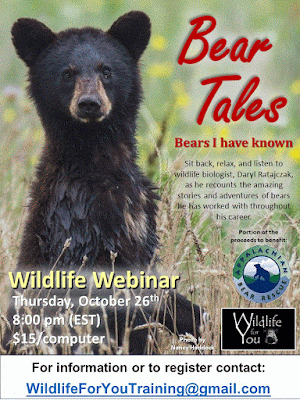It was late winter 1999 and the
bear center had a couple of neonatal cubs that needed fostering to wild mother bears.
We had already successfully fostered the cub’s sibling the week before so we
were eager to get this cub united with a new mom. It wasn’t going to be long. A
female had been located the day before within Great Smoky Mountain National
Park and she appeared to be in prime condition having recently given birth to a
few cubs of her own. She looked as if she would do just fine. The opportunity
seemed perfect so the arrangements were made with the University of Tennessee
bear researchers.
The next day, the hike to the den was nothing spectacular from a difficulty standpoint. In fact, it was rather simple and uneventful. It was only about a mile down a well-traveled trail and maybe thirty yards off the beaten path. What always made me smile seeing a den like this was how close by folks often walk to a sleeping bear. I have no doubt hundreds, if not thousands, passed within a stone’s throw of this mother and her cubs and none were the wiser.
The den
itself was a typical bear den for the Smokies, made from the remnants of a
monarch of a tree. This den, however, was not located up high within the bole
of the tree, for the tree itself was long gone. What remained was a behemoth of
a stump and a tangle of sturdy deep-reaching roots. I imagine in no time at all,
upon finding the remnants on the tree, mom had excavated a nice comfy cavity in
the loosely packed soil beneath. The freshly mounded dirt at the entrance of
her den still smelled of raw earth and quite honestly, it smelled heavenly.
It would
be a few minutes as the two lead researchers, Frank and Don, made careful preparations.
Cub in hand, I waited patiently a short distance away for them to sedate the
mother. Hibernating bears, though a little groggy at first are still a formidable
animal. Common sense also tells us it’s never a good idea for a rousing mother bear
to hear a bawling cub nearby by. I couldn’t help but imagine it would get the
adrenaline rushing in both the mother bear and the crazy stupid human holding
the cub (Me!).
 |
| Mother bears, though asleep, can wake relatively quickly. |
Needless
to say momma went down quietly and Frank and Don begin their work. Their first
order of business was to extract the female’s natural cubs and hand them to us
so we could collect measurements and apply our secret solution to the cubs,
also known as Vicks VapoRub (the reasoning for that process is described in a
different blog.) Interestingly enough, cub data wasn’t of utmost importance. When
it came to the primary study, one of the key aspects of their research was to
collect information to learn more about den selection. This included taking
measurements both inside and outside the den. The end goal of this research was
simply to find out what makes for a good bear den.
The cool
thing with this particular den was that it actually had two different
entrances, one in the front and a less conspicuous smaller entrance in the
back. I guess given the proximity of the den to the hiking trail, if the bear
wanted a way to make a hasty retreat should she need it, she could simply scoot
out the back. Fortunately the hole in the rear of the den was just large enough
for the second researcher, Don, to crawl into, but just barely. His job was to
replace the radio collar that was on the female’s neck since its battery life
was just about up. This was an ideal situation since with two people working
together to collect the information and replace the collar, it was only going
to take half the amount of time had only one person been able to crawl inside
the den.
Enter the
importance of communication!
 |
| A typical day doing bear den work. |
As we laughed about the situation, I could only imagine what was going through Frank’s mind the moment that sequence occurred…nose to nose with an unhappy momma bear in the confines of her den. All I can say is I am glad it wasn't me!
--------------------------------------------
To hear more "Bear Tales," and other wonderful bear adventures join Daryl Ratajczak as he recounts some of his favorite bear stories from his career as a wildlife biologist. The best thing...you can participate from the comfort of your own home! Register for his webinar titled, "Bear Tales" by sending an email to: wildlifeforyoutraining@gmail.com
A portion of the proceeds will be donated to the Appalachian Bear Rescue in Tennessee to care for orphaned and injured cubs from the Smokies and surrounding areas.
Registration and seat availability is first-come-first-served.


Oh, wow. That was quite a story! (And a happy, funny ending) I would have fainted if it was me in that den with Mama.
ReplyDeleteYou have such fantastic stories about your bear experiences!! Thanks for sharing them!!
ReplyDelete